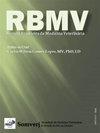巴西首都地区自然感染巴贝斯虫犬的分子检测及血液学变化
Q4 Veterinary
引用次数: 0
摘要
摘要犬巴贝斯虫病是世界上最流行的蜱传疾病之一,是巴西多地发现的一种地方病。贫血和血小板减少症是巴贝斯虫病犬最常见的血液学变化。本研究的目的是评估巴西巴西联邦农村大学小动物兽医医院服务的巴西巴西巴西大都市地区犬类中弓形虫的患病率和血液学变化。采用聚合酶链反应(PCR)扩增18S rRNA基因,并进行序列遗传鉴定。在随机分析的250份血样中,9份(3.6%)巴贝斯虫呈阳性。对经PCR鉴定为弓形虫阳性的血样进行测序,检测出沃氏巴贝斯虫。血浆阳性犬的主要血液学变化为贫血和血小板减少,分别有6只(66.7%)和8只(89%)出现贫血和血小板减少。结果表明,在研究的大都市区,大多数受感染的犬中,沃氏分枝杆菌是主要的螺旋体。螺浆病贫血的发生是多因素的,包括血管内和血管外的原因(Ayoob et al., 2010)。本研究中66.7%的螺浆菌阳性动物出现贫血。大多数动物的贫血、细胞增多症和多色症、白细胞减少症、淋巴细胞减少症和血小板减少症。本文章由计算机程序翻译,如有差异,请以英文原文为准。
Molecular detection and hematological changes in dogs naturally infected by Babesia vogeli in metropolitan region of Rio de Janeiro
Rosa, CEP 24220-000, Niterói (RJ), Brasil E-mail: renataqassad@yahoo.com.br Abstract Canine babesiosis, one of the most prevalent tick-borne diseases worldwide, is an endemic disease in Brazil that has been detected in several locations. Anemia and thrombocytopenia are the most common hematologic changes in dogs with babesiosis. The aim of this study was to assess the prevalence of piroplasms, and hematological changes found in dogs in a metropolitan region of Rio de Janeiro served by the Small Animals Veterinary Hospital of the Federal Rural University of Rio de Janeiro. The 18S rRNA gene was amplified by polymerase chain reaction (PCR) and sequence-based genetic characterization was performed. Of the total 250 blood samples that were randomly analyzed, nine (3.6%) were positive for Babesia spp. Samples identified as positive for piroplasms by PCR were sequenced and Babesia vogeli was detected. The predominant hematological changes in piroplasm-positive dogs included anemia and thrombocytopenia, which were observed in six (66.7%) and eight (89%) dogs, respectively. The findings indicate that B. vogeli was the predominant piroplasm in most of the affected dogs in the studied metropolitan region. Piroplasm can cause The development of anemia in piroplasmosis is multifactorial and results from both intra and extravascular causes (Ayoob et al., 2010). Anemia was observed in 66.7% of the piroplasm-positive animals in this study. anemia, anisocytosis and polychromasia, leukopenia, lymphopenia, and thrombocytopenia in most animals.
求助全文
通过发布文献求助,成功后即可免费获取论文全文。
去求助
来源期刊
CiteScore
0.80
自引率
0.00%
发文量
34
审稿时长
>12 weeks
期刊介绍:
The Brazilian Journal of Veterinary Medicine was launched in 1979 as the official scientific periodical of the Sociedade de Medicina Veterinária do Estado do Rio de Janeiro (SOMVERJ). It is recognized by the Sociedade Brasileira de Medicina Veterinária (SBMV) and the Conselho Regional de Medicina Veterinária do Estado do Rio de Janeiro (CRMV-RJ).

 求助内容:
求助内容: 应助结果提醒方式:
应助结果提醒方式:


